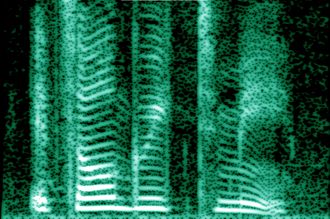Human voice
| Advanced search |
- About 7 results found and you can help!
The voice consists of sound made by a human being using the vocal folds for talking, singing, laughing, crying, screaming, etc. Its frequency ranges from about 60 to 7000 Hz. The human voice is specifically that part of human sound production in which the vocal folds (vocal cords) are the primary sound source. Generally speaking, the mechanism for generating the human voice can be subdivided into three parts; the lungs, the vocal folds within the larynx, and the articulators. The lung (the pump) must produce adequate airflow and air pressure to vibrate vocal folds (this air pressure is the fuel of the voice). The vocal folds (vocal cords) are a vibrating valve that chops up the airflow from the lungs into audible pulses that form the laryngeal sound source. The muscles of the larynx adjust the length and tension of the vocal folds to ‘fine tune’ pitch and tone. The articulators (the parts of the vocal tract above the larynx consisting of tongue, palate, cheek, lips, etc.) articulate and filter the sound emanating from the larynx and to some degree can interact with the laryngeal airflow to strengthen it or weaken it as a sound source.
- See also: Wikipedia, Wiktionary, Wikiquote, Wikibooks
- Related: Accent (linguistics), Acoustic phonetics, Belt (music), Histology of the Vocal Folds, Lombard effect, Manner of articulation, Paralanguage, Phonation, Phonetics, Speaker recognition, Speaker verification, Speech Synthesis, Vocal loading, Vocal rest, Vocal range, Vocal warm up, Vocology, Voice analysis, Voice disorders, Voice frequency, Voice organ, Voice pedagogy, Voice projection, Voice synthesis, Voice types
| The Head Voice and Other Problems The Head Voice and Other Problems www.gutenberg.org/etext/19493 - Web |
| The Voice Foundation's official website The Voice Foundation's official website www.voicefoundation.org - Web |
| The Anatomy of Singing The Anatomy of Singing www.singwise.com/.../main.pl?section=articles&doc=AnatomyOfVoice - Web |
Average relevance
| David Harper, vocal coach: A passion for the voice... David Harper, vocal coach: A passion for the voice that never wanes – Opera~Opera article www.opera-opera.com.au/archive/davidharper.htm - Web |
| Irish Voice festival official website Irish Voice festival official website www.spiritofvoice.com - Web |
| How the voice works-- The Voice Works Like a Car How the voice works-- The Voice Works Like a Car www.youtube.com/watch?v=-zXGGRiQbCo - Web |
| Voice acoustics: an introduction Voice acoustics: an introduction www.phys.unsw.edu.au/jw/voice.html - Web |
